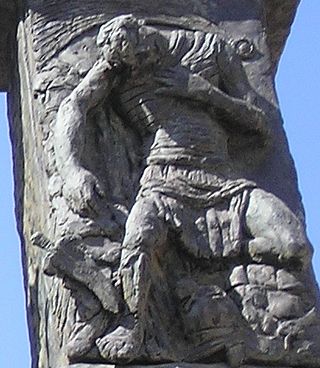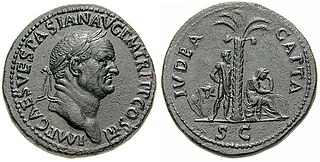
The new Israeli shekel, also known as simply the Israeli shekel, is the currency of Israel and is also used as a legal tender in the Palestinian territories of the West Bank and the Gaza Strip. The new shekel is divided into 100 agorot. The new shekel has been in use since 1 January 1986, when it replaced the hyperinflated old shekel at a ratio of 1000:1.

A shekel or sheqel is an ancient Mesopotamian coin, usually of silver. A shekel was first a unit of weight—very roughly 11 grams —and became currency in ancient Tyre, Carthage and Hasmonean Judea.

The First Jewish–Roman War, sometimes called the Great Jewish Revolt, the First Jewish Revolt, or the Jewish War, was the first of three major rebellions by the Jews against the Roman Empire. Fought in the province of Judaea, it resulted in the destruction of Jewish cities and towns, including the metropolis of Jerusalem, the displacement of its population, the appropriation of land, and the destruction of the Jewish Temple and polity.

The Bar Kokhba revolt was a large-scale armed rebellion initiated by the Jews of Judea, led by Simon bar Kokhba, against the Roman Empire in 132 CE. Lasting until 135 or early 136, it was the third and final escalation of the Jewish–Roman wars. Like the First Jewish–Roman War and the Second Jewish–Roman War, the Bar Kokhba revolt resulted in a total Jewish defeat; Bar Kokhba was killed by Roman troops at Betar in 135, and the Jewish rebels who remained after his death were all killed or enslaved within the next year.

Gamla, also Gamala, was an ancient Jewish town on the Golan Heights. Believed to have been founded as a Seleucid fort during the Syrian Wars, it transitioned into a predominantly Jewish settlement that came under Hasmonean rule in 81 BCE. The town's name reflects its location on a high, elongated ridge with steep slopes resembling a camel's hump.

The siege of Jerusalem of 70 CE was the decisive event of the First Jewish–Roman War, in which the Roman army led by future emperor Titus besieged Jerusalem, the center of Jewish rebel resistance in the Roman province of Judaea. Following a five-month siege, the Romans destroyed the city, including the Second Temple.

Judaea was a Roman province from 6 to 132 CE, which at its height incorporated the Levantine regions of Judea, Idumea, Samaria, and Galilee, and parts of the costal plain including Philistia, extending over the territories of the Hasmonean and Herodian kingdoms. The name Judaea was derived from the Iron Age Kingdom of Judah, that was centered predominantly in Judea.

A Zuz was an ancient Jewish silver coin struck during the Bar Kokhba revolt as well as a Jewish name for the various types of non-Jewish small silver coinage, used before and after the period of the revolt. The name was used from the Greek era of drachmas, through the Roman era of Denarius, and then as the quarter denomination of Bar Kokhba Revolt coinage. The Jewish insurrectionists' zuzim were overstruck on Imperial denarii or provincial drachmas of the emperors Vespasian, Titus, Domitian, Trajan, and Hadrian. Four zuzim, denarii or drachmas make a shekel, a sela or a tetradrachm.

Hasmonean coinage are the coins minted by the Hasmonean kings. Only bronze coins in various denominations have been found; the smallest being a prutah or a half prutah.

Judaea Capta coins were a series of commemorative coins originally issued by the Roman Emperor Vespasian to celebrate the capture of Judaea and the destruction of the Second Jewish Temple by his son Titus in AD 70 during the First Jewish Revolt. There are several variants of the coinage. The reverse of the coins may show a female seated right in an attitude of mourning at the base of a palm tree, with either a captive bearded male standing left, with his hands bound behind his back, or the standing figure of the victorious emperor, or the goddess Victoria, with a trophy of weapons, shields, and helmets to the left.

Bar Kokhba revolt coinage were coins issued by the Judaean rebel state, headed by Simon Bar Kokhba, during the Bar Kokhba revolt against the Roman Empire of 132–135 CE.
The procuratorial coinage of Roman Judaea was minted by the prefects and procurators of the province between AD 6 and 66 in only one denomination and size, the bronze prutah. All the coins were minted in Jerusalem.

Prutah is a Hebrew term, possibly derived from Aramaic. It refers to a small denomination coin.
Herodian coinage were coins minted and issued by the Herodian Dynasty, Jews of Idumean descent who ruled the province of Judaea between 37 BC – 92 AD. The dynasty was founded by Herod the Great who was the son of Antipater, a powerful official under the Hasmonean King Hyrcanus II.

The Yehud coinage is a series of small silver coins bearing the Aramaic inscription Yehud. They derive their name from the inscription YHD (𐤉𐤄𐤃), "Yehud", the Aramaic name of the Achaemenid Persian province of Yehud; others are inscribed YHDH, the same name in Hebrew. The minting of Yehud coins commenced around the middle of the fourth century BC, and continued until the end of the Ptolemaic period.

Tyrian shekels, tetradrachms, or tetradrachmas were coins of Tyre.

Horvat 'Ethri, or Umm Suweid, is an archaeological site situated in the Judean Lowlands in modern-day Israel. Excavations at the site have uncovered the remains of a partially restored Jewish village from the Second Temple period. The site features an ancient synagogue, wine presses, cisterns, mikvehs, stone ossuaries, and an underground hideout system.
Carthaginian or Punic currency refers to the coins of ancient Carthage, a Phoenician city-state located near present-day Tunis, Tunisia. Between the late fifth century BC and its destruction in 146 BC, Carthage produced a wide range of coinage in gold, electrum, silver, billon, and bronze. The base denomination was the shekel, probably pronounced in Punic. Only a minority of Carthaginian coinage was produced or used in North Africa. Instead, the majority derive from Carthage's holdings in Sardinia and western Sicily.

The Judean provisional government is a historiographical name for the short-lived de facto governing entity in Judea, which was established during the Great Jewish Revolt in the year 66 CE by Judean rebel forces of the Pharisee and Sadducee parties. It aimed to create and govern a full Jewish state, although its influence was concentrated in Jerusalem. The government functioned until the Zealot Temple siege in the year 68 CE, when most of its leaders were massacred in the inter-rebel struggle.

The Te'omim Cave, or the Twins Cave, Arabic name Mughâret Umm et-Tûeimîn, is a karstic cave within a nature reserve in Israel located on the western edges of the Jerusalem Mountains, in the vicinity of Beit Shemesh.





















